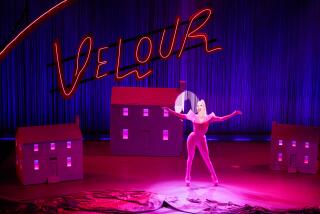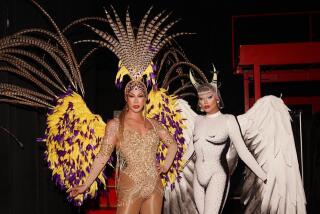Dragstrip 66: Saying goodbye is such a drag
This weekend, a truly iconic piece of L.A. club culture says a fond farewell: The monthly drag dance party Dragstrip 66 closes the curtains on a 17- year-long stretch of glitter-drenched, gender-blurring, pop culture playfulness.
Held at such iconic Eastside venues as Rudolpho’s, Safari Sam’s, the Echo and the Echoplex, this DJ dance night/deviant drag show attracted tens of thousands of patrons, inspired dozens of drag performers and club spinoffs, and quickly became a much-loved institution of underground Los Angeles night life.
Equally inspired by high fashion and lowbrow art, Dragstrip 66 carved out a niche for those who liked their night life tempo somewhere between a John Waters film, a Bob Mackie fashion show and a drunken punk dance party. It became a who’s who of the alternative/queer performance art scene; Jackie Beat, Joey Arias, Varla Jean Merman, Chi Chi LaRue and Jer Ber Jones all graced its stage. A-list celebrities showed up too: Marilyn Manson, Claire Danes, Roseanne Barr, Traci Lords, RuPaul, Alan Cumming, Drew Barrymore and Adam Lambert among them.
So why stop the party now? Some might say it’s a bittersweet but logical turn of events. DS66 is 17 years old -- a run that’s practically unheard-of in L.A. club culture, a virtual millennium in night-life years -- and its founders are, quite honestly, getting tired.
“Frankly, our daytime careers have made it harder to give Dragstrip the time and attention we did in the past,” says Dragstrip co-founder Mr. Dan Der Kacz. Others may chalk it up to a cultural shift: Perhaps the practice of drag isn’t the potent political statement it once was, no longer as shocking. Which leaves Dragstrip in a bit of a time warp, straddling a sizable generational gap in the gay community in L.A. Even so, its absence will be palpable. Dragstrip inspired a unique approach to L.A. clubbing at a time when gay night life was mainly a one-dimensional, West Hollywood-based scene.
Dragstrip was founded by longtime friends Paul V. (club promoter and DJ of Bootie LA and Indie 103.1) and theater producer-performer Mr. Dan, who’s become known as “the Weird Al Yankovic of drag parody.” It was 1993, on the cusp of the Clinton administration, and for these two Boston transplants, necessity was the mother of invention. Says Paul V., “After I moved here in 1988, I saw how limited the options in gay night life were. It felt like, if you didn’t go to West Hollywood, you didn’t go out. We wanted to change that, to create a place that we felt comfortable in. Somewhere friendly, funny and fierce at the same time.”
Mr. Dan played the gregarious host, letting loose his drag persona, Gina Lotriman, each month to belt out parodies of pop songs and encouraging patrons to dress in costume (drag or not) supporting twisted themes such as “Tranny Get Your Gun,” “Turban Renewal” and “Hooray for Bollywood.” Paul V. turned traditional notions of “gay dance music” upside down, spinning gutsy combos of industrial, dance, punk and rock music.
As a concept, it was risky, to say the least. But by the third month, the place was crawling with hundreds of glamorous queens, misfits and pierced gay punks, all rubbing elbows inside the cramped quarters of Rudolpho’s Mexican Restaurant. Early club-goers, such as James Boulet (co-founder of the monthly Miss Kitty’s club), recall the ironic charm of Dragstrip’s first venue: “Here was this little dingy restaurant with 5 million gay scenesters and drag queens packed inside. It was like a clown car, packed and fun as hell!”
Jackie Beat remembers: “It was also messy and monstrous in a way that plucked and tanned WeHo would never tolerate, so even within the gay community it felt somewhat subversive.”
This subversive behavior continued even in the face of the law. A pivotal memory for many patrons was June 12, 1993, when, as club-goer Scott Craig remembers, “The LAPD and LAFD showed up to shut Dragstrip down for [allegedly] being over capacity. They herded all these fabulous freaks into the parking lot and everyone refused to leave. Mr. Dan got up on a car and screamed out, ‘We refuse to leave! We’re not hurting anyone!’ A helicopter hovering above decided to turn on the bright search light and, well, the crowd went crazy -- like someone had put them on stage. Ultimately, the cops let us back in to finish our party!”
Fast-forward past several evolutions in gay culture and three different venues for Dragstrip, and its founders feel it’s time to move on to new projects. Paul V. thinks that the move from Rudolpho’s in 2004 -- a decision he says was beyond their control -- was difficult for club morale and helped spur the end of an era. “It was hard for a lot of people to lose that ‘house party’ feeling we had at Rudolpho’s, for sure,” he says.
Although there are a handful of places in the L.A. area that have a DS66 feel -- including Miss Kitty’s, Moustache Mondays and the popular Eastside watering hole Akbar -- the loss of this boisterous monthly fixture undoubtedly will leave a void.
“It was like Stonewall meeting Warhol meeting the Sunset Strip meeting Haight-Ashbury all in the aftermath of an AIDS-plagued decade,” says Craig, co-owner of Akbar. “We were happy to party. We needed to party.”
More to Read
The biggest entertainment stories
Get our big stories about Hollywood, film, television, music, arts, culture and more right in your inbox as soon as they publish.
You may occasionally receive promotional content from the Los Angeles Times.










